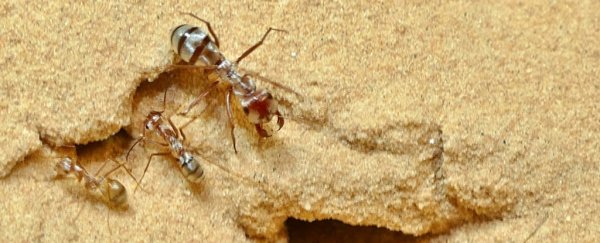When you think of fast animals, it's probably something like cheetahs, or greyhounds. But when measuring in body lengths per second, the arthropod world is unmatched. And now we have a new record-holder - the fastest speed ever measured in an ant.
The winner is the Saharan silver ant (Cataglyphis bombycina), and the speed is 855 millimetres (33.66 inches) per second.
That may not sound like much to you, but that's 108 times the insect's body length per second. Even the cheetah can only manage 16 body lengths per second. Usain Bolt's top speed is 6.2; if he could travel at Saharan silver ant speeds, his top running speed would be around 800 kilometres per hour.
For running speed (flying speeds get even more intense), this puts the ant third, behind the Californian coastal mite (Paratarsotomus macropalpis) at 322 body lengths per second, and the Australian tiger beetle (Cicindela eburneola) at 170 body lengths per second.
These tiny ants are amazing. In the Sahara desert, where most creatures avoid going out in the middle of the day to avoid blistering temperatures over 50 degrees Celsius, the Saharan silver ant has evolved a number of adaptations to do just that.
They have longer legs than other ants, to keep their bodies farther from the scorching sand. Their bodies produce heat shock proteins not in response to heat, but before even leaving the nest, for maximum heat resistance.
They track the Sun to always be aware of the shortest route back to the nest. They're covered in unique hairs with a triangular cross-section that keep their bodies cool by reflecting the Sun's radiation, and offloading excess thermal radiation.
And they move extremely fast, so they can be in and out of the heat as quickly as possible. They spend just a few minutes outside the nest scavenging the carcasses of fallen desert creatures before zooming back in again.
To find out not just exactly how fast, but how the ants get to such speeds, biologists from the University of Ulm in Germany decided to film them in high speed.
First, they had to locate a nest - no easy task, since the ants spend such little time outside. But then, when that was accomplished, the next part was much simpler. They attached an aluminium channel to the entrance, with a feeder at the end to lure them out of the nest.
"After the ants have found the food - they love mealworms - they shuttle back and forth in the channel and we mounted our camera to film them from the top," said biologist Sarah Pfeffer.
In addition, the team carefully excavated a nest and brought it back to Germany, to see how the ants moved in cooler temperatures.
 (Sarah Pfeffer/University of Ulm)
(Sarah Pfeffer/University of Ulm)
In the intense heat of the desert, the ants are at maximum efficiency. The top speed recorded was 855 millimetres per second. Back in the lab in Germany, at temperatures of just 10 degrees Celsius, they were much slower - just 57 millimetres (2.24 inches) per second.
The team also compared the top running speed to the larger Cataglyphis fortis, which also lives in the Sahara desert and maintains a similar lifestyle to C. bombycina. C. fortis has a top speed of 620 millimetres per second - only 50 body lengths.
Yet, compared to its body, C. bombycina's legs are 20 percent shorter than those of C. fortis - so how does it move so fast?
The high-speed video helped solve this too - it's all in the speed and control of the gait. The Saharan silver ant can swing its legs at speeds up to 1,300 millimetres per second, extending its stride from 4.7mm to 20.8mm as it reaches higher speeds.
When it's running at over 300 millimetres per second, it hits a full gallop, with all six feet off the ground at once, its footwork tightly synchronised, each foot making contact with the ground for as little as 7 milliseconds. This could help minimise sinking into the sand.
The next step in the research is to try to figure how the ants' musculature allows them to move at such mind-blowing speeds.
The research has been published in the Journal of Experimental Biology.
